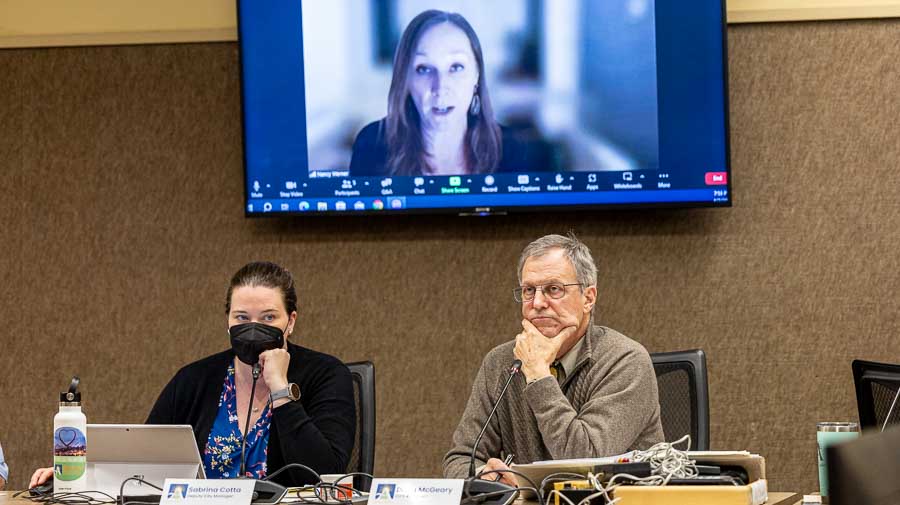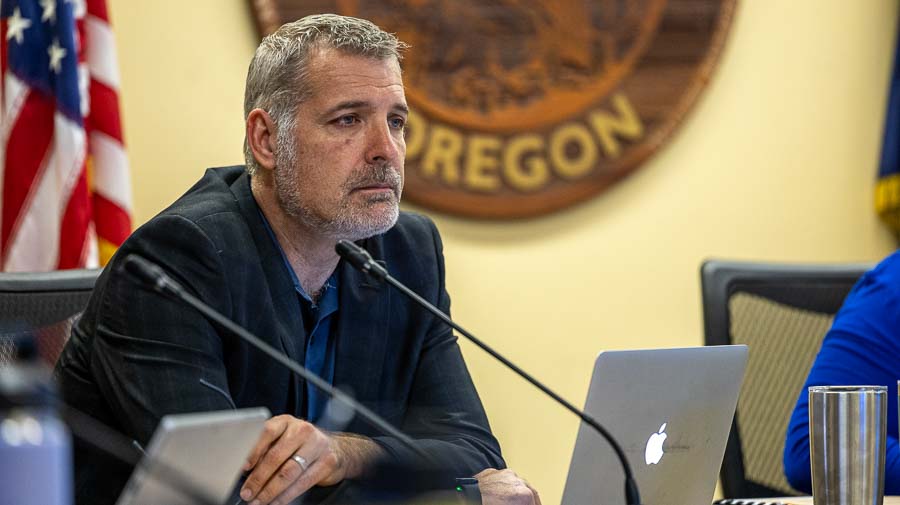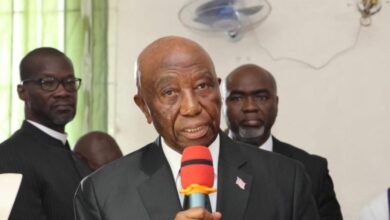‘More protection than doing nothing’: Telecommunications ordinance update enacted – Ashland News

In face of withering public comment, council votes 5-1 to adopt design standards for small wireless facilities
By Morgan Rothborne, Ashland.news
In the face of vociferous opposition from some Ashland residents, the City Council on Tuesday approved the second and final reading of its new telecommunications ordinance by the same 5-to-1 vote as the first reading.
The ordinance updates a portion of the city’s telecommunications ordinance to establish design standards for small wireless facilities in public rights-of-way in the city, which is expected to come into play as cell phone service providers transition from using 4G technology, which relies on fewer, larger towers, to 5G technology, which requires use of more numerous, smaller antennas.
Around two dozen people lined the streets in front of Council Chambers just before the Tuesday evening meeting holding signs in protest of the ordinance.
Ivy Ross, one of the founding members of Oregonians for Safer Technology, said after six years of work on this issue, OST members are frustrated, but maintain their resolve to oppose the ordinance as insufficient protection from 5G technology.
Ross said concerns of lawsuits from the Federal Communications Commission and telecommunications companies repeatedly stated by Ashland City Councilors should take into consideration that residents who feel they were not adequately protected by their representatives can also pursue legal action.
“They have a kind of personal liability risk when they enact something that is harmful,” Ross said.
OST began as a dozen people in a living room, she said. Over the last six years, the group grew into an organization in multiple Oregon cities with a board of directors and a mailing list sent to hundreds. The group has consistently supplied information to the public and members of the city government through public comment and one-on-one meetings with the mayor, councilors and city attorneys. The group has also raised thousands to hire telecommunications attorney Andrew Campenelli. When they learned the city hired a different attorney “out of left field,” members were extremely frustrated.
Inside the council chamber Tuesday, it was beyond standing room only as people leaned against walls and sat on the floor. Mixed in among those in opposition to 5G technology were proponents of a ceasefire in Gaza and members of Southern Oregon Climate Action Network and Ashland High School students there to support an electrification ordinance.
Those speaking in opposition to the telecommunications ordinance filled nearly an hour of public comment populated with academic and legal references, descriptions of health conditions, threatening language and song.

Kristi Chiposky said her young daughter became debilitated and mostly homebound with migraines and panic attacks. After the family moved as far as possible from cell towers, her daughter’s condition disappeared. A new cellular installation proposed at Southern Oregon University is so close to their home that they are considering moving again.
“People like my daughter are canaries in the coal mine, eventually we will all feel it as the effects are cumulative,” she said.
Russell Witte said in two decades of research on microwave and ultrasound waves, he could reference thousands of studies that came to conclusions pointing to a necessity of expert-led public discussion surrounding the risks of this technology. Tonya Simmons quoted a seven-year study to determine the safety of cell phone use which found them to be unsafe. Vicki Simpson warned of famine, referencing an Israeli study showing 5G millimeter waves kill insects, including pollinators.
A man who submitted his public comment form as “The Man known as Andre Brandord,” said his reference to, rather than possession of, a name is because he is a “free man.”
“If any one of you bring harm to a free man or a free woman, the law of equity is on our side and there are many of us here that have experience with that. If you trespass against us, we have no resort but to make amends using the law of equity,” he said.
Derek Franklin said opponents of the ordinance are now telling, rather than asking, the council to “do the right thing.”

“We are now engaged to the point where, if this continues going forward, it’s going to get a lot worse,” he said.
After stating his residence and name, Bob Jackson Miner broke into song at a volume and gusto usually found on stage in a musical. He then returned to a speaking voice and took issue with council ignoring the science brought forward by the group.
Immediately after him, Teresa Demarie told council she had already tried so hard to reach Ashland city government she felt she had to resort to prayer. Demarie then began singing “Amazing Grace.” The majority of the audience joined in singing the hymn for the duration of her public comment. While Mayor Tonya Graham has previously silenced the audience from any vocalizations outside individual speakers in public comment, she allowed the song.
After public comment concluded, Graham asked if Campanelli’s ordinance and comments on the city’s ordinance had been reviewed. Councilor Jeff Dahle said it had and asked the city’s contracted attorney Nancy Werner to state if this input had been considered in drafting the city’s ordinance.
Werner responded in the affirmative. Moving through Campanelli’s five suggestions, ranging from providing probative evidence of a tower’s necessity of installation to the inclusion of public utility easements and the language used in the preamble of the ordinance, Werner said that she considered all suggestions and structured Ashland’s ordinance to provide the most control and security possible for the city within the boundaries of federal law.
Councilor Bob Kaplan asked Interim City Attorney Doug McGeary what would happen if a wireless provider approached the city with an application without the new ordinance in place.
McGeary responded that the then-in-place ordinance did not provide the city with the ability to control the placement of towers based on aesthetics — the strongest leverage point under federal law — because it was designed for large cell towers, not small cell wireless facilities.
Werner said the Federal Communications Commission requires aesthetic standards be in place in writing prior to the receipt of an application. Without the new ordinance, the city would be attempting to negotiate a deal with the applicant in the face of a “shot clock” — a federally mandated window of time in which to make a decision.

When Dahle made the motion to approve the second reading of the new ordinance, McGeary read into the record a section added between readings mandating rules and accountability for the neighborhood meetings required of applicants in the discretionary review process.
“I want to sincerely thank everyone who has been involved in this year’s long, rigorous and certainly emotional discussion,” Dahle said in speaking to his motion.
He assured the audience every email, in person or phone conversation, was heard and said he hoped to see a continuation of civilized debate held in good faith even as elected officials may come to a conclusion that does not satisfy all their constituents.
Councilor Paula Hyatt said she had also listened to residents’ concerns on this issue consistently since taking her seat on council, including clicking every link to every video and study sent to her. Hyatt said she would vote to support the ordinance because it provides more protection than leaving the previous ordinance in place.
Councilor Eric Hansen referenced his own conversations and meetings with residents in support and opposition to the ordinance. While he recognized the emotional power of the issue, he criticized the public comment offered that evening.
“I am saddened by the threats and the theatrics in this room. It is important that we respect each other and that we respect this process,” he said.
Councilor Gina DuQuenne voted in opposition, while Hyatt, Dahle, Dylan Bloom, Hansen and Kaplan voted in favor.
In other council business Tuesday, the council approved additional funds to conduct helicopter logging work in an area of the watershed between Reeder Reservoir and the city’s water treatment plant. The additional work would cost an estimated $340,616.12, with a projected offset through the sale of thinned logs of $161,320.40, according to meeting materials.
Council also unanimously voted to create an ad hoc committee for a masterplan for the 2200 Ashland St. building and to approve a new fire code for the city.
Email Ashland.news reporter Morgan Rothborne at morganr@ashland.news.
Video of the April 2 Ashland City Council meeting is available by clicking here.



